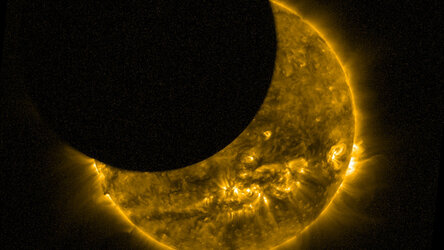Accept all cookies Accept only essential cookies See our Cookie Notice

About ESA
The European Space Agency (ESA) is Europe’s gateway to space. Its mission is to shape the development of Europe’s space capability and ensure that investment in space continues to deliver benefits to the citizens of Europe and the world.
Highlights
ESA - United space in Europe
This is ESA ESA facts Member States & Cooperating States Funding Director General Top management For Member State Delegations European vision European Space Policy ESA & EU Space Councils Responsibility & Sustainability Annual Report Calendar of meetings Corporate newsEstablishments & sites
ESA Headquarters ESA ESTEC ESA ESOC ESA ESRIN ESA EAC ESA ESAC Europe's Spaceport ESA ESEC ESA ECSAT Brussels Office Washington OfficeWorking with ESA
Business with ESA ESA Commercialisation Gateway Law at ESA Careers Cyber resilience at ESA IT at ESA Newsroom Partnerships Merchandising Licence Education Open Space Innovation Platform Integrity and Reporting Administrative Tribunal Health and SafetyMore about ESA
History ESA Historical Archives Exhibitions Publications Art & Culture ESA Merchandise Kids Diversity ESA Brand CentreLatest
Space in Member States
Find out more about space activities in our 23 Member States, and understand how ESA works together with their national agencies, institutions and organisations.
Science & Exploration
Exploring our Solar System and unlocking the secrets of the Universe
Go to topicAstronauts
Missions
Juice Euclid Webb Solar Orbiter BepiColombo Gaia ExoMars Cheops Exoplanet missions More missionsActivities
International Space Station Orion service module Gateway Concordia Caves & Pangaea BenefitsLatest
Space Safety
Protecting life and infrastructure on Earth and in orbit
Go to topicAsteroids
Asteroids and Planetary Defence Asteroid danger explained Flyeye telescope: asteroid detection Hera mission: asteroid deflection Near-Earth Object Coordination CentreSpace junk
About space debris Space debris by the numbers Space Environment Report In space refuelling, refurbishing and removingSafety from space
Clean Space ecodesign Zero Debris Technologies Space for Earth Supporting Sustainable DevelopmentLatest
Applications
Using space to benefit citizens and meet future challenges on Earth
Go to topicObserving the Earth
Observing the Earth Future EO Copernicus Meteorology Space for our climate Satellite missionsCommercialisation
ESA Commercialisation Gateway Open Space Innovation Platform Business Incubation ESA Space SolutionsLatest
Enabling & Support
Making space accessible and developing the technologies for the future
Go to topicBuilding missions
Space Engineering and Technology Test centre Laboratories Concurrent Design Facility Preparing for the future Shaping the Future Discovery and Preparation Advanced Concepts TeamSpace transportation
Space Transportation Ariane Vega Space Rider Future space transportation Boost! Europe's Spaceport Launches from Europe's Spaceport from 2012Latest

What is a solar eclipse?
Thank you for liking
You have already liked this page, you can only like it once!
A solar eclipse happens when the Sun, Moon and Earth are perfectly aligned. The Moon blocks light from the Sun and casts a shadow on Earth. The eclipse is visible to anybody within this shadow.
A solar eclipse can be either total, annular or partial. During a total solar eclipse, the Sun, Moon and Earth are perfectly aligned and the Moon covers the entire disc of the Sun. During an annular solar eclipse, the Sun's outer edge remains visible as a bright ring around the Moon. This happens because the size of the Moon in the sky changes as it moves along its elliptical orbit around Earth: the Moon appears smaller when it is farther away. During a partial solar eclipse, the Moon does not pass directly between the Sun and Earth, so only part of the Sun is covered by the Moon – it looks as though the Moon takes a bite from the Sun!
Solar eclipses occur about every 16 months and ‘totality’ (when the Sun is completely covered by the Moon) can last up to seven and a half minutes depending on the Earth-Moon-Sun geometry. Considering that the Moon takes 28 days to orbit Earth, why do we not see a solar eclipse every month? Because the orbit of the Moon around Earth is tilted, so the Moon often crosses above or below the imaginary line connecting the Sun and Earth. It is only when the Moon crosses this line that we see a solar eclipse.
Discover more about eclipses here.
[Image description: Graphic showing how the Moon (grey circle, centre) creates a solar eclipse by passing directly between the Earth (blue-green circle in the bottom right) and the Sun (yellow-orange circle in the top right). Lines trace the light rays travelling from the Sun's outer edges to Earth, outlining the areas of full shadow (highlighted dark purple) and partial shadow (highlighted light purple) cast by the Moon on Earth.]
-
CREDIT
ESA -
LICENCE
ESA Standard Licence

A partial solar eclipse seen from space

Proba-2 partial eclipse, 26 February 2017

Proba-2’s predicted view of 2 July eclipse

Proba-2 sees two partial eclipses















 Germany
Germany
 Austria
Austria
 Belgium
Belgium
 Denmark
Denmark
 Spain
Spain
 Estonia
Estonia
 Finland
Finland
 France
France
 Greece
Greece
 Hungary
Hungary
 Ireland
Ireland
 Italy
Italy
 Luxembourg
Luxembourg
 Norway
Norway
 The Netherlands
The Netherlands
 Poland
Poland
 Portugal
Portugal
 Czechia
Czechia
 Romania
Romania
 United Kingdom
United Kingdom
 Slovenia
Slovenia
 Sweden
Sweden
 Switzerland
Switzerland
























